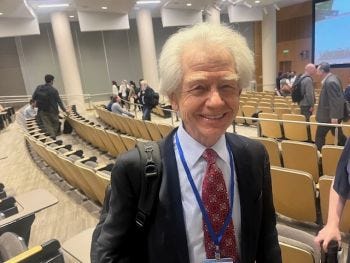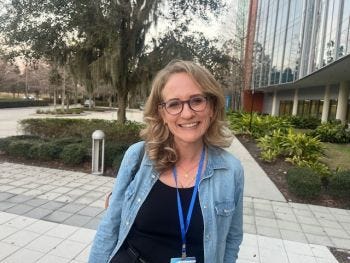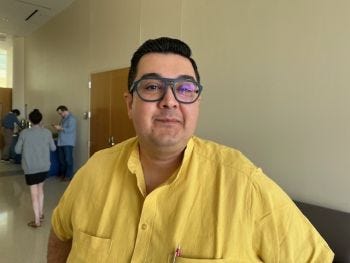Scientific experts who study Mitragyna speciosa and are contributing to shaping its future gathered recently at the Fourth International Kratom Symposium.

At a Glance
- Researchers from around the world gathered in February at the Fourth International Kratom Symposium.
- The gathering highlighted the explosion in kratom research over the last decade.
- Researcher said event underscored “how far the science on kratom has advanced but also how far we still have to go.”
LAKE NONA, FLORIDA — The first week of February, I ditched my Colorado home basement and coffee-stained keyboard, headed southeast to the barren lands of Denver International Airport and jetted to Orlando to attend a conference on kratom.
I was destined for an academic enclave in the company of researchers who study Mitragyna speciosa, the tropical tree native to Southeast Asia. Kratom’s leaves and constituents appear in a medley of products consumed by millions of Americans for various reasons, including to treat pain and opioid use disorder.
The researchers came to the University of Florida’s Research and Academic Center from all over the world. Canada. Czech Republic. Germany. Indonesia. Italy. Thailand. Malaysia. And yes, Colorado, Maryland and elsewhere across the United States.
The Fourth International Kratom Symposium in Lake Nona, which is part of Orlando, covered a range of issues from highly technical science that had me searching for aspirin to emerging trends in product formulations and policy discussions. Over a few days, under warm, sunny skies, I attended presentations, shared meals and hobnobbed with a “who’s who” of the kratom research community — both foreign and domestic experts. I also bumped into business executives, representatives of industry trade groups and consumer advocates.

Surge of kratom research and funding
During one of the breaks, I caught up with Jack Henningfield, Ph.D., vice president of research, health policy and abuse liability at Pinney Associates and an adjunct part-time professor in the Johns Hopkins School of Medicine. Henningfield, who’s been studying drugs for nearly half a century, said the kratom symposium brought together leading researchers from around the globe.
“In any area of neuroscience and evaluating potential substances that are used by people — for good or for bad — you need to know the basics,” he said. For instance, Henningfield cited the need to research the safety of a natural compound like kratom in animal and human studies and understand the effects of the plant’s constituents.

[Jack Henningfield, Ph.D., pictured above, highlighted an explosion of kratom research over the last decade].
Henningfield expressed exuberance because an increase in funding from the National Institute on Drug Abuse (NIDA) — an agency within the National Institutes of Health (NIH) — “unleashed a lot of talent all over the United States,” particularly at the University of Florida and more recently at Johns Hopkins School of Medicine. A few months after I interviewed him, the Washington Post reported (on April 16) that NIH faced a proposal by the Trump administration to slash its budget by 40 percent.
Research into kratom has exploded over the last decade.
“Eighty percent of all of the publications in the last 35 years have been published in the last 10 years, and a lot of them with NIDA’s support,” Henningfield told me. “NIDA’s helped us learn a lot that can serve people in the United States and globally.”
Asked about leading kratom research universities in the U.S., Henningfield described the University of Florida (UF) as the “big dog” that conducted some of the earliest research. He said other universities have become influential researchers in the space too, including Johns Hopkins University and Columbia University.
I was curious about the number of researchers who study kratom. Henningfield estimated the figure is in the hundreds, perhaps approaching 1,000.
“There’s hundreds at different levels because in any research program you have the leaders,” plus the junior faculty and post-doctorate researchers, he explained, “and they’re all offering “different ideas, and that is what is making this field move so quickly and innovate.”
The power of collaborative kratom research
Nicole Beurkens, Ph.D., is a scientific advisor to dietary supplement companies. While speaking with me at the symposium, she underscored the value of bringing together academics from around the globe to learn about all aspects of kratom research in cell models, animals and humans.
The shared knowledge “helps get us all on the same page with what data has already been collected, what we already know, and then helps us identify the gaps of what we still need to know so that we can build on those studies,” said Beurkens, who was attending the kratom symposium for the first time.

[Nicole Beurkens, Ph.D., pictured above, suggested the research on kratom needs to be more widely shared].
“As Jack Henningfield said this morning, the vast majority — like 80 percent — of the studies we have are from the last decade, so there’s been a huge increase in the amount of data and it’s exciting,” she added.
Generally speaking, there’s an inaccurate perception that kratom hasn’t been the subject of much research, Beurkens observed. She suggested the research needs to be more widely disseminated so the public and clinicians are aware of the actual scientific data that has been collected.
Kratom’s research boom and medical potential
Kratom researcher Christopher McCurdy, Ph.D., is a chemist, behavioral pharmacologist and pharmacist at UF. He has attended all of the kratom symposiums, including an event held in Malaysia in 2017. He recalled that he was only one of three people from the U.S. who attended the event, which was hosted by Universiti Sains Malaysia (USM) on the island of Penang.
The meeting featured heavy representation from Malaysia, and McCurdy didn’t recall that anyone from Indonesia or Thailand — other places where kratom is native to the land — was present. McCurdy spearheaded the first kratom symposium in the U.S. in 2019 in Lake Nona, which he described in a phone interview as fairly small.
The third kratom symposium was held in 2024, and this year’s event was the largest to date, with global representation and around 100 people attending, based on McCurdy’s estimates.
“The research has just exploded over the last four or five years, and it’s still on an upward trajectory,” said McCurdy, associate dean for faculty development and professor of medicinal chemistry at the UF College of Pharmacy.
McCurdy suggested that early funding for kratom research was focused on the plant’s potential to treat opioid use disorder. He said research has expanded to examine other possible medical uses and health benefits beyond harm reduction, related to such myriad areas and conditions as the gut microbiome, autoimmune and neurogenerative diseases, and diabetes.
As the research has evolved, so has the marketplace. While kratom leaf materials and extracts remain available to consumers, products featuring heavily concentrated isolates like 7-OH (7-hydroxymitragynine) are flooding online and in-person stores.
“Unfortunately, the research is still trying to figure out what the leaf is doing,” McCurdy remarked.

[Christopher McCurdy, Ph.D., pictured above, presents at the Fourth International Kratom Symposium in Lake Nona at the University of Florida’s Research and Academic Center].
Clarifying kratom’s identity amid market confusion
Paula Brown, Ph.D., is among the handful of kratom researchers who helped organize this year’s kratom symposium. Brown is an expert in the natural health and food product industry, specializing in research on product quality, safety and efficacy. She is director of applied research at the British Columbia Institute of Technology (BCIT) and also has served for the last 10 years as Canada Research Chair in Phytoanalytics.
Brown recalled joining the second kratom symposium in 2019, which she described as a “very intimate event” of experts sharing unpublished data. She said last year’s symposium brought in more researchers from abroad.
Brown said she can barely keep up with the kratom research these days, explaining, “I have a person designated in my research lab who just searches for all the new papers every week … because there’s so much being published.”
Research on kratom is especially important, Brown told me in Lake Nona, because there has been significant “confusion” and “misinformation.” For example, she cited statements made years ago by the U.S. Food and Drug Administration that researchers felt were not “an accurate representation of kratom as a botanical.”

[Paula Brown, Ph.D., pictured above, is among the kratom researchers in North America who have expressed concerns over 7-OH products].
“And then more recently, the confusion has been, ‘What is kratom?’” she said. “We just need to be really clear that when we’re talking about kratom, we’re talking about the biomass” and the leaves and preparations used traditionally.
She referenced other products, including kratom extracts and things that “aren’t even kratom at all” and that Brown maintained pose a danger to public health. Asked whether products containing concentrated amounts of 7-OH should be classified as a dietary supplement, the Canadian researcher responded, “Absolutely not.”
7-OH is not naturally present in kratom leaves, she said, though it can be detected in dried leaves or when they are processed.
“We see the same thing in cannabis,” Brown said. “You have some cannabinoids that are really artifacts of processing and drying, not naturally in the plant.”
Synthetic derivatives of a naturally occurring compound — even the main compound in kratom, mitragynine, packaged as a single alkaloid — aren’t dietary supplements, the natural products researcher maintained.
“Kratom is the dietary supplement. That’s the plant,” she said.
Isolating a single molecule, Brown added, takes it away from herbal medicine and traditional use. Complicating the issue, 7-OH products contain other unknown compounds, according to Brown.
“Dietary supplements need to be presumed safe,” she said. “You have a reason to believe that they’re safe, and we don’t have that evidence for [7-OH]. We do for kratom.”
How kratom transformed one woman’s life with fibromyalgia
It wasn’t just researchers who I encountered at the Fourth International Kratom Symposium. Outside the building where the presentations were being held, Melody Woolf, of Kalamazoo, Michigan, told me this is her 11th year taking kratom. She has fibromyalgia, which Johns Hopkins University characterizes as “a condition that causes pain in muscles and soft tissues all over the body.”
She said when her kids were in elementary school, they would “sleep with fans in their rooms at night … because they heard mom crying at night in pain. And that’s just no way for a kid to grow up.”
Woolf said she was taking multiple prescription meds, including a fentanyl patch at all times, to treat her pain. After hearing about kratom online, she started researching it and decided to try it.
“When I went to order it, my husband said, ‘What? It says … not for human consumption,’” she recalled. “So that was way back in the day, 11 years ago.”

[Kratom user and advocate Melody Woolf, pictured above, attended the Fourth International Kratom Symposium, which the University of Florida hosted in Lake Nona].
Woolf has been taking kratom daily since then and told me the botanical has improved her quality of life. Though she still lives with pain, without kratom, Woolf said, she would need the aid of a walker, “and if I were to go anyplace like to visit a tourist attraction, I would have to be pushed around in a wheelchair.”
Kratom’s cultural and legal landscape in Malaysia
One evening during the symposium, a few kratom academics picked me up at the hotel to go to dinner. I was under the impression it was going to be an intimate meal, but when we arrived at the restaurant, I was surprised to see dozens of attendees — most of whom I didn’t know — standing around and chit-chatting.

[Darshan Singh, Ph.D., pictured above, is associate professor at the Centre for Drug Research at Universiti Sains Malaysia].
I spent some time becoming acquainted with another big personality in the kratom space, Darshan Singh, Ph.D., associate professor at the Centre for Drug Research at Universiti Sains Malaysia. He educated me on the culture in Malaysia and discussed differences in how kratom is consumed there versus in the U.S.
“In Southeast Asia, there is no such thing as 101 [different] kratom products,” he shared. “You only get to see kratom in the form of fresh leaf. You get to see dried kratom powder leaf.”
He said the majority of it is consumed as a kratom tea, or so-called decoction, which a 2023 research paper in the journal Regulatory Toxicology and Pharmacology described as “a water extract prepared by boiling kratom leaves for several hours.”
Most Malaysians no longer chew the leaf, Singh explained, after the government began regulating kratom over 20 years ago (in 2003) and making it an offense to possess the botanical. Under a law approved in 2024, he said, “authorities will be given the power to actually detain anyone suspected under the influence of kratom. They can randomly stop anyone on the street.”
In Malaysia, there is an export ban on kratom and most of it entering the U.S. comes from Indonesia, according to the researcher. Although the law in Malaysia criminalizes consumption, distribution, possession and export of kratom, “shockingly the law does not criminalize kratom cultivation,” Singh said.
He said the government faces a catch-22 because the country has kratom plantations that are 40 years old and destroying the trees would mean having to wait decades to reach the same growth. Controlling consumption of kratom also is challenging, he said, because the people can grow the trees behind their homes.
Kratom’s regulatory future under new leadership
When it was time to order our dinner, I sat down across from Sheldon Bradshaw, an attorney who works for Elevation Capital, a venture capital firm that owns companies operating in the botanical space. I learned that once upon a time (from April 2005 to October 2007, according to his LinkedIn profile), Bradshaw was chief counsel at the U.S. Food and Drug Administration. He also served as a principal deputy assistant attorney general with the U.S. Department of Justice.
We had a friendly chat, and the next day during a break in the presentations, Bradshaw granted me a request for an interview to discuss the symposium, as well as regulatory and political developments in Washington, D.C.
Bradshaw said he was impressed with the speakers at the kratom symposium — academics from Asia, Canada, Europe and the U.S., and he enjoyed learning about the different kinds of kratom research happening around the world.
I was curious whether Bradshaw thought the second Trump administration, new FDA commissioner and Robert F. Kennedy Jr. (now secretary of the U.S. Department of Health and Human Services) would be good for the kratom space. To the consternation of industry and consumer advocates, FDA has concluded that kratom is not lawfully marketed in the U.S. as a drug product, a dietary supplement, or a food additive in conventional food.

[Former FDA attorney Sheldon Bradshaw, pictured above, discussed the potential regulatory treatment of botanicals like kratom under the second Trump administration and HHS Secretary Robert F. Kennedy Jr.].
“To what extent does politics play a role in a decision by FDA, for example, to pivot on its policy?” I asked Bradshaw.
“The FDA is one of the many umbrella agencies within the Department of Health and Human Services. So ultimately, entities like the FDA report to the secretary of HHS and ultimately that secretary of HHS reports to the White House,” Bradshaw responded. “So, if you had a secretary of HHS who, for example, was a strong proponent of botanicals, I think that would obviously filter down to the FDA with respect to how they approach botanicals. And I’m not sure I would call it politics as much as I would say that every new administration has the opportunity to go in and change policy and priorities.”
At the time I interviewed Bradshaw, RFK Jr. hadn’t been confirmed yet by the U.S. Senate to lead HHS. Bradshaw said Kennedy had made statements suggesting FDA had failed to do enough to promote the “nascent potential or promise of botanicals as it relates to public health.”
Bradshaw concluded “botanicals will probably have an easier pathway to the marketplace under the administration of Donald Trump,” though the lawyer said he wasn’t aware if RFK Jr. had a position on kratom.
“He’s never made any statements about kratom,” Bradshaw said, “but he’s made lots of statements about botanicals and the need to have more botanicals as an alternative to … the modern approach to medicine focused on drugs.”
Reflecting on the evolution of kratom science
I most likely wouldn’t have had the opportunity to attend the symposium in February had I not met a kratom researcher 10 months earlier in Oxford, Mississippi, during the International Conference on the Science of Botanicals.
Her name is Kirsten Smith, Ph.D., and she is an assistant professor of psychiatry and behavioral sciences at the John Hopkins School of Medicine, and one of the members of the committee that organized the kratom symposiums in 2024 and 2025. Others who have been on the committee since 2024 include Brown, McCurdy, Singh and two other academics at the University of Florida: Abhisheak Sharma, Ph.D., a co-director of translational drug development core and assistant professor at University of Florida, Gainesville; and Oliver Grundmann, Ph.D., assistant dean for lifelong learning and clinical professor at the UF College of Pharmacy.
I recently asked Smith about her takeaways from the Fourth International Kratom Symposium. She highlighted “how far we as a scientific community have come — how far the science on kratom has advanced — but also how far we still have to go.”
“U.S. adults have been using kratom for at least 20 years. Sometimes, I think we forget how long this documented use has occurred in America, never mind the centuries of use in Southeast Asia,” Smith told me over email.
Another takeaway from this year’s kratom symposium, she said, is “recognition of the continued need for interdisciplinary collaboration between academics and public health officials, spanning agriculture to preclinical and clinical research, and all of the related toxicology and epidemiological systems we have.”
She further called for collaboration with industry and state and local government.
Smith described the Fourth International Kratom Symposium as “a team effort and true coming together.”
“We just need that conciliatory spirit to endure in the coming years,” she concluded, “particularly with challenges that impact all of use, such as novel product formulations masquerading as kratom.”

[Kirsten Smith, Ph.D., pictured above, is among about a handful of experts who organized the Fourth International Kratom Symposium].









